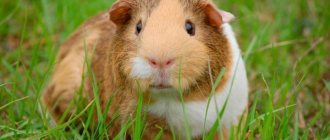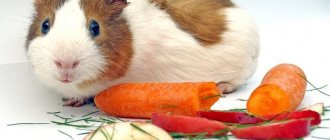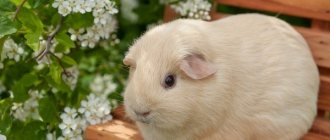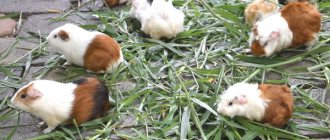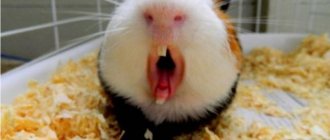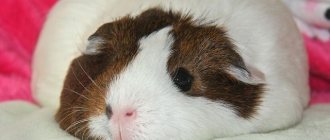The guinea pig squeaks, purrs, whistles, growls and, in general, is musical and talkative. Everything that people explain in words, the animal expresses in various sounds and movements. According to the observations of experts, the language of a rodent is very diverse and includes more than a dozen different sounds. Each sound signal has its own meaning, so it’s quite possible to understand what your pet wants to say. To learn your pet's language, you only need observation. A little time - and the animal can be understood at a glance, or rather, at a half-sound.
What signals do guinea pigs make?
In various circumstances, a pet may:
- squeak;
- squeal;
- whistle;
- sniffle;
- rumble;
- grunt;
- coo;
- growl;
- moan;
- hiss, etc.
If an animal lives with a relative, it is important to distinguish when neighbors communicate with each other and when they turn to the owner. The latter cannot be ignored. The pig turns to the owner - it means that she needs him and she needs his help, care and guardianship.
The animal makes most of its sounds at night - this is the time of its activity. In order not to think until the morning what to do if a guinea pig squeaks (whistles or makes another sound), it is important to know what exactly the animal is signaling with this or that sound.
When communicating
If an animal grunts when surrounded by its own kind, then in this way it greets its relatives and shows a friendly attitude. Purring or rumbling is a sign of sympathy that an animal experiences when being near its owner or another pet. The guinea pig is an extremely friendly and sociable animal. Therefore, she manages to experience loneliness extremely poorly.
Don't be alarmed if you hear a loud squeal when you get home.
This is how the pet conveys the joy of the owner’s arrival and invites them to chat soon.
How to understand what a pig needs
The main thing that the owner of the animal needs to learn to understand it is diligence and attentiveness. Many animals have their own, characteristic style of communication. But still, the meanings of most sounds are the same for all pigs. Therefore, it will not be difficult to find out why guinea pigs squeak, whistle, sniffle and make other sounds. But in order to correctly understand your pet, it is important to correctly recognize the sound being made - growling or rumbling, hissing or snuffling, etc.
Variety of breeds
Species diversity is characteristic not only of dogs and cats, but also of guinea pigs. The photos demonstrate that there are both short-haired and long-haired breeds. The conditions of detention are the same for all, with the exception that long-haired dogs need to be combed and, in some cases, trimmed. The most popular breeds are:
- American Teddy;
- English self;
- satin;
- alpaca;
- skinny;
- Himalayan;
- Peruvian;
- Abyssinian;
- Sheltie;
- texel;
- crested.
They all have differences in coat type and color, as demonstrated by photos of guinea pigs. In addition, there are outbred smooth-haired and rosette pigs. Everyone is equally good-natured, trusting and timid, which makes them incredibly cute.
Why does a pig squeak, sniffle, whistle, growl, hiss, coo or chatter his teeth?
Guinea pigs squeak most often out of pleasure. A guinea pig squeaks when you pet it, which is a good sign that your pet is enjoying what is happening. If the animal is doing well and is happy with its life, the pet can squeak lightly or grunt all day long. Therefore, if a rodent squeaks all the time, this is not a reason for concern, but quite the opposite - you can only be happy for your happy pet.
A pet's wheezing is a common occurrence, indicating excited or impatient anticipation. Noisy snorting or whistling can be heard when the animal is in anticipation of a treat. But sometimes such sounds indicate a lack of attention - the pet is really waiting for the owner to play with him or simply pay attention.
The animal's whistle can be both a greeting and a reminder of feeding. In the first case, the guinea pig whistles when it sees its owner after separation (for example, he comes home from work, etc.). Usually, when the greeting whistle is given, the pet stands up on its hind legs to demonstrate how glad it is to meet you. Sometimes, instead of whistling, the pet squeaks loudly as a greeting. In the second case, the animal whistles when it is hungry and there is no food in the bowl. Owners who do not want to constantly receive sound “reminders” should make sure that their pet’s feeder is not empty - fill it in a timely manner and put in more food.
Pigs begin to growl, not when they are unhappy, as one might expect, but during the mating season. These sound signals are especially characteristic of males.
Cooing is the characteristic sound of mother pigs. If, while caring for the babies, the pet coos, this means that everything is fine both with the cubs and with the mother herself.
The pet begins to hiss, chatter (or grind) its teeth and grin when it is in a bad mood. At this time, it is better not to touch the animal; for games and “cuddling” it is better to wait until the pet is in a good mood. Otherwise, the pet’s internal negativity and aggression will spill out on the owner in the form of a bite.
What to feed?
Guinea pigs are herbivores, so the basis of their diet should be hay. It should be in the cage at all times, just like water and food. Specialized food for such rodents can be purchased at a pet store. At the same time, you should avoid those that contain grain, as it is not absorbed properly in the animal’s stomach.
In addition to dry food, a guinea pig should receive two servings of fresh vegetables and fruits, as well as herbs daily - they are rich in vitamins and microelements and are vital. The optimal dose of succulent food is about 10% of the animal’s own weight daily.
Why does the pig scream, squeal and whine?
These sounds are equivalent to an alarm. Hearing them, the owner should run to the animal - it calls for help. The reasons can be different - the pet is scared of something, he feels bad or is in pain. In any case, he needs support and love.
If your pet screams or squeals, first of all you need to examine him. Perhaps he fell or got into a fight with a relative, or someone offended him. It is imperative to make sure that the animal is not injured and there are no abrasions on its body. If damage is detected, medical attention must be provided to him.
By moaning and whining, the little furry is able to express his dislike for someone (a person or a relative) or simply signal his loneliness. Regardless of the reason, the animal needs to be comforted and cuddled. Nothing makes a pig as happy as the owner's love. Well, and a delicious treat, of course.
Chirps or tweets
The pig can not only squeak and purr, but also chirp and chirp like a bird. The feeling from such sounds is as if the pet is singing. Such sounds mean an extreme degree of excitement.
The pig sometimes chirps for up to half an hour, not noticing anyone around, immersed in an exciting state. This is how she experiences severe stress.
The expectant mother can thus announce to everyone around her that she will have cubs. The male can use his chirping to attract the female to mate. If two pigs are chirping among themselves, you don't have to worry. Nothing bad happens.
What do guinea pig movements mean?
The sounds made by the pig are often accompanied by movements. In order to correctly understand what is wrong with her, it is important to pay attention to both. For example, the meaning of rumbling may differ depending on the combination with movements. If the rumbling is quiet and the movements are smooth and natural, the animal is happy and satisfied. If the rumbling is shrill and the movements are jerky, the pet expresses its dissatisfaction. Upon closer examination, you can see that when it purrs, the animal shakes, as if it were having a chill.
Meanings of movements outside of sounds
Guinea pigs are distinguished not only by their sociability, but also by their mobility. They are able to express their thoughts, requests and desires through movements.
Rising on its hind legs, the pet wants to please the owner - it shows itself in all its glory. Stretching forward (in the usual position - on four legs), the animal looks around and examines the surrounding objects - a manifestation of alertness.
If a pet is jumping, it is in a good mood and wants to hint to the owner that it is time to play. The animal shakes, shudders, clenches its paws and tries to hide in the far corner - it is very scared.
If your pet is frozen and does not move, as if he were a toy, it means that he feels a threat, danger, and wants to wait it out. A grin is evidence of aggression. If the owner does not want to get bitten, it is better not to come into contact with the animal at such a moment.
Learning to understand a furry pet is not difficult. Yes, pigs don't speak human language, but that doesn't mean they don't speak. Their system of communication with people and relatives is quite simple and understandable. The observations required to learn their language will not take much time. After this, the owner is guaranteed complete understanding with the little pet.
Moments to be wary
A heart-rending cry means that the animal is afraid or feels pain. And at the moment he feels bad. As soon as you hear something like this, immediately go to your pet to see if everything is okay with him.
You should also pay special attention to teeth grinding. This means that the animal’s teeth begin to grow, but toys and solid food do not help.
If the situation is left unchecked, an infection may occur. And in this case, you should immediately consult a doctor.
A veterinarian tells more about the language of communication between guinea pigs and the outside world in the video below.
A rare sound made by guinea pigs. It really is very similar to the chirping of birds. Not all guinea pigs make this sound. Many owners have never heard it from their pets. But some people have a pig (or even a pair) that makes this sound relatively often.
This chirping can vary in frequency (faster, slower) and volume. It may seem that while chirping the pig is in a trance-like state: some climb onto the house and sing their “song” with their heads held high; some climb into a secluded place (a pipe, a house, huddle in a corner) and look extremely worried. At the same time, the pig sits motionless, not paying attention to anything, with his eyes wide open, looking at one point. Usually, relatives living in the same cage with the songbird or in the same room become quiet and can also sit motionless.
The duration of such “singing” can range from 30 seconds to 20 minutes. When the singing ends, the pig goes about its normal business as if nothing had happened. This behavior and the meaning of this “song” are the subject of much debate. There are different explanations for this behavior.
In the book “Behavioral Differences Between Domestic and Wild Guinea Pigs” (Mammaliology Section, Vol. 52, 1987, pp. 294-307)*, Dr. Adelheid Stanke defines chirping as follows:
“Chirping is one of the loudest sounds in the vocalization repertoire of guinea pigs. Sounds are produced in quick, rhythmic succession. When guinea pigs can be observed doing this activity, in addition to the mouth, the whole body also moves under the influence of the efforts made to reproduce this sound. The chirping can occur for up to 20 minutes, during which a maximum of 100 sounds per minute will be produced. In 20 minutes, 800 sounds were counted.
The chirping has been recorded in two different situations: animals in a state of high arousal and stress following a major conflict. In the first case, the sound was a response to an unfamiliar environment or an unexpected sound. In the second (the most common of a number of cases) during specific social phenomena within the group, such as the establishment of rank or during conflicts (in males), when females were ready to reproduce. The chirping never occurs during skirmishes, but often only after several minutes or hours.”
Norbert Sachser (“Social Physiology: Guinea Pig Studies.”*) describes chirping as a stress signal. He's writing:
“Animals chirp mainly when they are socially overloaded, which does not allow them to cope properly in a certain social situation. Overall, chirping is a very rare occurrence.”
People have offered various reasons and explanations for this unusual behavior. Many guinea pig owners have concluded that chirping often occurs during the estrous period of females and in cases of ambiguous social status of the pig in the group, especially when joining an established flock. Often, skirmishes, conflicts and clarification of social rank are the cause of tweeting. The pig cannot occupy a certain level on the hierarchical ladder, which causes it to be in a state of stress. Also, there is an assumption that they tweet out of loneliness. It has been noted that in the wild this signal is a “warning” to other pigs that danger is nearby.
Conclusion:
Various factors are responsible for the mysterious chirping of guinea pigs. To make approaches to explain this phenomenon and more or less understand your pet, you need to observe him before and during this behavior.

